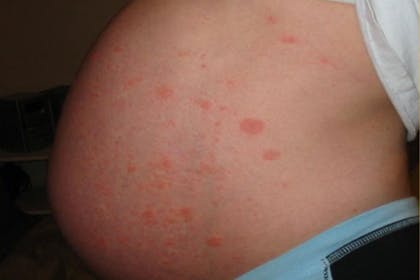Polymorphic eruption of pregnancy (PEP) and PUPPP: symptoms and treatment

Polymorphic eruption of pregnancy (PEP) (previously called pruritic urticarial papules and plaques of pregnancy, or PUPPP) is a fairly common skin condition that can affect pregnant women. Learn the symptoms to look out for, plus what to do if you think you have it.
This page contains affiliate links, which means we may earn a small amount of money if a reader clicks through and makes a purchase. All our articles and reviews are written independently by the Netmums editorial team.
What is PEP or PUPPP?
PEP stands for polymorphic eruption of pregnancy. According to the NHS, it's a fairly common and usually harmless skin condition, which can affect pregnant women.
The main symptom to look out for is a rash, and it usually goes away on its own - but more on this below.
PEP used to be known as pruritic urticarial papules and plaques of pregnancy (PUPPP), and you may still hear that term used in other countries. It means the exact same thing as PEP, which is now the more common term in the UK.
FREE NEWBORN NAPPIES
What are the symptoms of PEP or PUPPP?
The most obvious symptom of PEP or PUPPP is an itchy rash, most likely on your belly.
You may notice some itching before the rash appears. It's always wise to mention any itching during pregnancy to your midwife or GP, so that they can check that it is definitely PEP or PUPPP and not another pregnancy condition called Intrahepatic Cholestasis of Pregnancy (ICP) which has more serious implications..
With PEP or PUPPP, the itching then develops into a raised, red rash. This most commonly appears on the belly – especially around stretch marks – though it can also appear elsewhere, such as under your breasts or on your arms and legs. It's unlikely to spread to your face, though.
PEP or PUPPP most often affects first-time mums-to-be, usually around the third trimester. It's also more common in women expecting twins or more. However, it can happen to anyone; no matter how many times you've been pregnant, and at any stage of pregnancy (even soon after your baby is born).

The PEP rash can be pretty irritating, but we've got plenty of tips to help you deal with it below. The good news is that PEP will not harm your baby in any way.
What should I do if I think I have PEP or PUPPP?
If you have any kind of rash or itching in pregnancy, it's always best to see your GP or midwife as soon as possible.
PEP itself is usually harmless, but there are other potential causes of itching or rashes that can be more serious (such as ICP - see above), so it's always best to get the diagnosis confirmed.
Your GP or midwife may refer you to a dermatologist for a proper diagnosis. Depending on the appearance of the rash, a dermatologist may be able to diagnose you just by looking at your rash, or they may ask for skin or blood samples to rule out anything more serious.
What's the treatment for PEP or PUPPP?
Unfortunately, there's no specific cure for PEP or PUPPP – it usually goes away on its own soon after the baby is born.
However, if the itching is bothering you, your GP may be able to recommend particular creams or emollients, or prescribe a steroid cream to help with the itching.
In more severe cases, your GP may recommend tablets (usually oral antihistamines), to further help control the itching.
Only in extreme cases will steroid tablets be considered – these can also help the itching, but may cause side-effects for you or your baby, so should only be used if really necessary.
Your GP will explain your options and help you choose the right treatment for you.
What can I do myself to feel better with PEP or PUPPP?
According to the NHS and Healthline, the following tips may help to relieve the itching of PEP or PUPPP:
- Take cool baths or showers.
- Wear loose clothes in natural fibres like cotton.
- Dampen some cloth with cool water and lay it over the irritated area.
- Try creams or lotions if you want, but avoid any scented ones, which may irritate skin further (your GP or pharmacist can advise on the best creams to use).
- Take an oatmeal bath (pop some oats into a sock, tie it up, then pop it in your bathwater. Leave it for a few minutes to let the oats infuse in the water before bathing).
- Avoid scratching as much as possible (if you find it hard to resist at night, some soft mittens might help).
Is it safe to breastfeed if I have PEP or PUPPP?
Yes. According to the NHS, it's perfectly safe to breastfeed your baby if you have PEP or PUPPP.
I've had PEP or PUPPP before. Will I get it again?
It's possible, but it's not likely.
According to the NHS, less than 7 in 100 women who get PEP in their first pregnancy will go on to get it again the second time around.
Plus, if you do get it again, chances are it will be milder than it was the first time.
Dealing with itchy skin in pregnancy? Check out our articles below, or get tips from those who've been through it in our forum:
Related stories
Itching in pregnancy: everything you need to know

